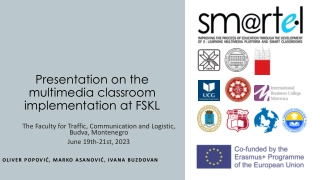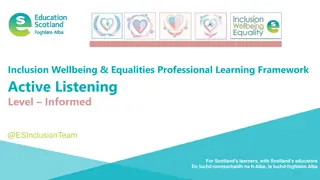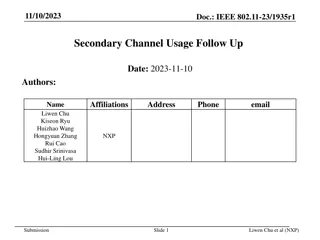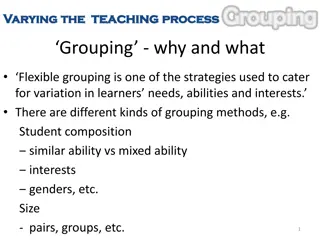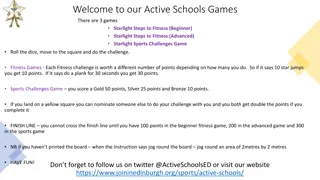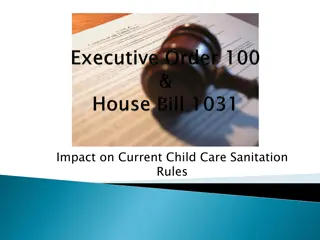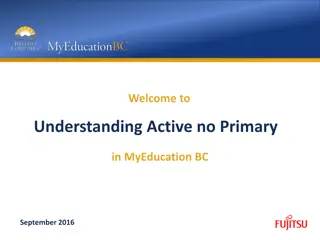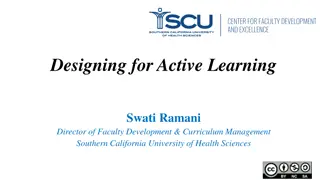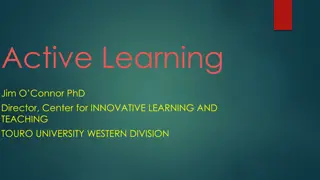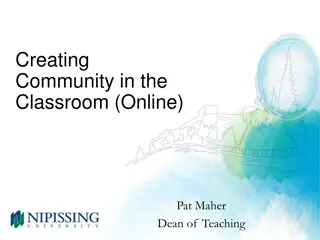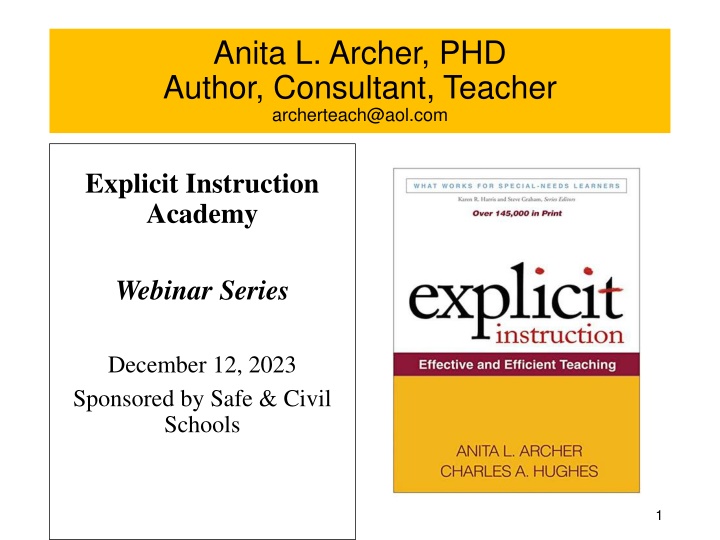
Effective Strategies for Active Participation in Secondary Classes
Enhance student engagement and learning by implementing active participation strategies in secondary classes. Learn why frequent responses are crucial, how to maintain a positive learning environment, and the benefits of eliciting student feedback. Expert tips from Anita L. Archer, PHD, on improving teaching and learning outcomes.
Download Presentation

Please find below an Image/Link to download the presentation.
The content on the website is provided AS IS for your information and personal use only. It may not be sold, licensed, or shared on other websites without obtaining consent from the author. If you encounter any issues during the download, it is possible that the publisher has removed the file from their server.
You are allowed to download the files provided on this website for personal or commercial use, subject to the condition that they are used lawfully. All files are the property of their respective owners.
The content on the website is provided AS IS for your information and personal use only. It may not be sold, licensed, or shared on other websites without obtaining consent from the author.
E N D
Presentation Transcript
Anita L. Archer, PHD Author, Consultant, Teacher archerteach@aol.com Explicit Instruction Academy Webinar Series December 12, 2023 Sponsored by Safe & Civil Schools 1
Active Participation in Secondary Classes Learning is NOT a Spectator Sport. How well you teach = How well they learn Everyone Does Everything Every day, in every class, every student is participating by speaking, writing, or doing. 2
Active Participation during Webinar Yes No Agree Disagree True False Active Participation during Webinar Short Choral Responses muted Choral Reading muted Written Responses Hold-ups Questions Chat Box A B C D 3
Our Universal Goal Teaching Learning Teaching Learning Teaching Learning Teaching Learning Teaching Learning Teaching More Learning Teaching More Learning Rehearse Rehearse Rehearse Rehearse Retrieve Retrieve Retrieve Retrieve 4
Delivery of Instruction: Require frequent responses 5
Active Participation Why? Why is it important to frequently elicit responses from students in secondary classes? Brain Drain List your ideas Put your best idea in the chat box. 6
Feedback Why is it important to frequently elicit responses from secondary students? Contributes to a positive learning environment - increases engagement - increases on-task behavior - increases accountability - promotes desired behaviors - reduces inappropriate behaviors - keeps class moving along 7
Feedback Why is it important to frequently elicit responses from secondary students? Embedded formative assessment Check for understanding - allows the teacher to monitor understanding, adjust the lesson based on responses, and provide feedback to students 8
Feedback Why is it important to frequently elicit responses from secondary students? Promotes learning -focuses students attention on critical content -provides practice of skills, strategies, facts - provides rehearsal of information and concepts - allows for retrieval practice of critical content 9
Frequent Responses WHY? Clear and Consistent Research Results: Increases time on task Increases academic achievement (Learning) Decreases disruptive behaviors Increases intensity of interventions Research Review of 15 studies MacSuga-Gage & Simonsen, 2015 10
Instructional Cycle Input Question Response Monitor Feedback Adjust Input Question Response Monitor Feedback Adjust Input Question Response Monitor Feedback Adjust Input Question Response Monitor Feedback Adjust Input Question Response Monitor Feedback Adjust Input Question Response Monitor Feedback Adjust Input Question Response Monitor Feedback Adjust Input Question Response Monitor Feedback Adjust Input Question Response Monitor Feedback Adjust Input Question Response Monitor Feedback Adjust 11
Active Participation Essentials Essential No. 1: Request frequent responses from students. Essential No. 2: Require overt responses saying, writing, doing. Every day, in every class, every student is participating by speaking, writing, or doing. Essential No. 3: Involve all students. Everyone Does Everything (Feldman, 2021) No Hands Raisedpolicy No Opt Out Essential No. 4: Structure the active participation procedures. Essential No. 5: Provide adequate think time/preparation time. 1. Allow adequate thinking time/preparation time 12
Low Prep High Outcome Active Participation Procedures Verbal Response Procedures Structured Choral Responses Structured Partners Structured Teams Individual (Non-Volunteers) Structured Discussions Written Response Procedures Inclusive Passage Reading Silent Reading/ Whisper Reading Short Choral Reading Short Cloze Reading Structured Partner Reading (Me or We) Structured Team Reading (Me or We) Action Response Procedures Hold-ups Computers Whiteboards (Slates) Short Written Responses Use of Technology Tablets Hand Signals Response Cards Response Sheets 13
Structured Choral Responses When to use: Use when answers are short and the same. Use when rehearsal of information is desired. Provide quick retrieval review. What is critical: Provide a signal or cue so students respond together. Redo item when some students don t respond. (a gentle redo) Provide thinking/preparation time when needed. 14
Structured Partner Responses When to use: Use when answers are long or different. Use when cognitive processing is necessary (paraphrasing, explaining, elaborating, summarizing, comparing, evaluating). Use when students are: 1. Responding to a question, task, or directive 2. Teaching information to a partner 3. Studying with a partner 15
Structured Partner Responses What is critical: Assign the partners. Give partners a designation (1 or 2, A or B). Teach Look, Lean, Whisper. Teach Look, Lean, Listen, Low Voice. (Kevin Feldman. 2023) Give a job to both partners. (Agree-Disagree-Why, Paraphrase) Change partners occasionally. 16
Individual Responses (Non-Volunteers) When to use: To check an individual s understanding. To have students report their written or partner responses. To increase accountability. 17
Individual Responses (Non-Volunteers) What is critical: Establish a no-hands-raised environment. (Schoolwide) When I ask a question, don t raise your hands. Raise hands if you have a public question. Raise hands if the teacher directs you to raise your hands Have students prepare responses/answers. Next have them share answers with their partners. Then call on individuals. Cold Calls VS Hot Calls If the group size is more than 4, utilize a randomization tool. 18
Randomization Tools Procedures for randomly calling on students Procedure #1 - Write names on cards or sticks. Pull a card or stick and call on a student. Procedure #2 - Use iPad or iPhone app (e.g., Teacher s Pick, Stick Pick, or Pick Me!) Procedure #3 - Use two decks of playing cards. Tape cards from one deck to desks. Pull a card from other deck and call on a student. 19
Structured Class Discussion When to use: When a class discussion that involves all students is desired. What is critical: Provide a well-designed question or prompt. Have students plan their responses to the prompt before the discussion. Have students record their talking points. Have students share their ideas with their partners before the discussion. Establish rules of conduct for a discussion. In a large class, have students discuss the prompt with their team of 6 to 8 members. 20
Hold-Ups White Boards When to use: Anytime the answers are short and can be written on a slate. Quick review Benefits: You can hold all students accountable and monitor all students. 21
Hold-Ups Fingers When to use: - Students are selecting an answer from a numbered list. They indicate their answer by holding up fingers matching the numbered answer. - When they are selecting answer from four multiple choice possible answers. 22
Hold-Ups Fingers Retrieval Practice of Vocabulary when states left the United States more than 1/2 of the votes for a law extra tax paid on an import or export a government agency where nonelected people carry out government business to cancel an agreement right to vote 1. 2. 3. 4. 5. 6. suffrage majority tariff nullify secede bureaucracy 23
A. What detail from the article BEST shows how Arthur Fry invented the Post-It? 1. Spencer Silver invented a new glue that didn t hold things together for long. 2. Arthur Fry sang songs in the church choir. 3. Arthur Fry attached little pieces of paper to pages in his songbook using the new glue. 4. Spencer Silver and Arthur Fry both invented new types of glue. 24
A. What detail from the article BEST shows how Arthur Fry invented the post-it? 1. Spencer Silver invented a new glue that didn t hold things together for long. 2. Arthur Fry sang songs in the church choir. 3. Arthur Fry attached little pieces of paper to pages in his songbook using the new glue. 4. Spencer Silver and Arthur Fry both invented new types of glue. 25
Hold-Up Response Cards General Response Cards Yes Agree No Disagree Correct True Incorrect False 26
Hold-Ups Specific Academic Response Cards Executive Branch Legislative Branch Judicial Branch 27
Hold Hold- -Ups Ups Response Sheet Response Sheet Yes No Agree Disagree True False A B C D 28
Hold-Ups What is critical: Ask a clear question. Have students initially indicate the correct answer on their desks, not in the air. Monitor student responses. When adequate preparation time has been given, say Show me. Provide feedback. When appropriate, have students defend their answers. 29
Mottos for Webinar Learning is not a Spectator Sport.Anita Archer Every day, in every class, every student is participating by speaking, writing, or doing. Anita Archer Everyone Does Everything. Kevin Feldman How well we teach = How well they learn 30

